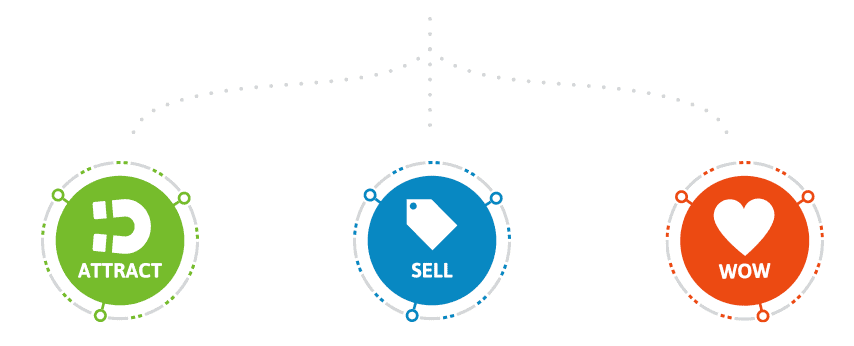The majority of businesses today have a website, but only a small number really know how to position their web presence to advantageously communicate with their target customers. Why? Because many assume that customers shop the same way on the Internet as they did in the past when printed brochures and catalogs were the principal marketing format. To our surprise, many young companies today also approach it the same way. They assume customers will do a Google or ChatGPT search for their business website, read about their company’s products, services and history, then buy from them. Reality is quite different.
On the Internet, consumers use search/AI engines to find the information they want. They compare providers and read online reviews. If your web presence satisfies their initial needs, they may explore your website further. If not, they will continue to explore other websites. The essential question is: What type of information will attract today’s customers and set your business apart?
Here are 3 key factors that will help you win customers with your online marketing efforts:
1. Helpful & Interesting Content
More than ever before, consumers want to find relevant information quickly to weigh their options before making their final decisions. They no longer accept a small number of options. That worked in the past when TV and printed ads were the two main forms of visual media “pushing” their promotions at the consumers. In this informational AI age, consumers get pretty good at ignoring that type of “pushed” content. They want good information (often instantly) to help them make informed decisions to explore further or move on. I call this the customers’ “initial needs.”
When I refer to content, I mean information in all formats such as: text, images, audio, or video. In order to make your content interesting to your target market, you need to know what information they are looking for when they begin their search and which channels they will use to search for that information.
At first, it’s the customers’ “initial needs” that will prompt them to search and explore. In the end, it’s their “real needs” that will make them decide to choose you as their provider of choice (or not). By “real needs,” I mean the experience customers would gain from your products or services. For example:
Let’s say you own an auto shop. When a customer purchases a replacement of four new tires from you, what that customer actually purchased from you is not the tires, but “the experience” as their vehicle gets better traction on the road, especially during the rainy or winter season.
This also applies to businesses that provide services instead of products. Here is an example: Imagine that you own an insurance agency. When a customer purchases an auto insurance plan from you, she does not purchase that piece of insurance paper. She purchased what the insurance “does” for her. Her “real purchase” is the assurance, knowing that if an accident happens, her insurance plan will cover it for her.
With knowledge of these two key attributes that customers are looking for when searching and selecting online, you can customize your website’s content to address them. Here’s how:
You need to provide helpful content to point out the great benefits and experience your products or services can bring. For example, if your auto shop sells tires as the rainy season approaches, then instead of just posting special offers and stating that you sell tires, you should focus on content that explains how the new tires will keep drivers and their family members safer on the road. The idea of being safer on the road will get people’s attention more than the fact that your business sells tires or has special offers. This is how you attract the customers’ attention and differentiate yourself from many other auto shops who used the generic approach by just listing their products and special offers.
Another way to produce enticing content is to conduct a survey with people who would most likely be your target customers. Ask them what they want to know about your products or services. Make a list of the most common questions, then produce content addressing those topics. After that, post them on your website where it’s easy for your potential customers to find these answers. Helpful content helps potential customers feel that you really understand them and their needs. This boosts their confidence in you and your business while increasing your conversion rate.
To attract more customers to your great content you need to amplify it. One good way to do this is to find out which channels and websites your target customers visit most often. Where do they hear about your types of products and services? Where do they “hang out?” Use those sources to make them aware of your content. A good tactic is to try to get a backlink on those websites pointing back to the content page on your website. A word of caution here: the less “sales-y” your content sounds, the more likely your backlinks will be approved and shared on those channels, especially on social media sites. Here are a few examples:
a. 3 Steps to Producing Content that Interests Your Customers
b. 10 Things Entrepreneurs Can Do to Improve Odds for Success
c. Attention Agents: Have You Cultivated This Important Asset Yet?
2. Outbound and Inbound (permission-based) Marketing
The Internet has opened a wide array of options for consumers around the world. It has changed the way people search for information and make purchasing decisions. It no longer works well to “push” your content at potential customers (outbound marketing). It’s much more effective to “pull” them in with it (inbound marketing). The secret is to pull your target audience toward your information with relevant and interesting content (especially if it’s information they have been searching for).
Just think, why would your customers choose you if your website displays pretty much the same content of specialties, products, services, and special offers as those of your direct competitors? How is your business different from others? To distinguish your message and relate to your customer on a deeper, more significant level, you need to communicate on two levels to address the customers’ “initial needs” as well as their “real needs.“
By providing relevant information to address these needs, you help customers gather good information to make a better decision. You will be regarded as the expert on the topic, which can boost your chances of being selected by those customers. This seems like a lot of work, but that is how you position yourself above the competition. Here is the reality: today’s attractive and effective websites are the ones you build for your customers. It’s no longer productive to build a website that’s “all about you.” It’s important to position your helpful content visibly and prominently, even before and beyond the introduction about your products, services and company.
3. Good Online Reviews = Trusted Signals
As humans, no one wants to be the lab rat. Customers always want to see what others have been saying about a provider that they are considering. This means that online reviews such as Google Reviews, Yelp Reviews, etc. can be one of the key factors in a customer’s decision making process. You can bet customers will most likely look for online reviews about your business because they are only a few clicks away from that information.
That said, it is very important for you to keep asking your happy customers to give you reviews on these sites. The level of importance for each review channel depends on your industry. If you run a restaurant, Yelp will be one of the most important review channels for your business. Google Review seems to be an important channel for most businesses.
Meanwhile, if you have a number of bad (legitimate) reviews that are affecting your overall scores, you should try to contact those unhappy customers to work it out and increase those scores or have them remove their bad reviews. If you don’t have time or don’t want to deal with it, you can hire an online reputation management company to work on it for you. They will reach out to your dissatisfied customers to remedy matters for you.
One note to remember: no matter how much time or money you invest in advertising and praising your business, nothing will measure up to the voices of your delighted clients. My ultimate recommendation is to keep improving your services and products to meet your customers’ expectations. That will help you maintain a high rating, not only with online reviews, but also with repeat businesses and referrals.
By now you should have a pretty good idea of how to focus your web presence on the three key attributes that will position your business more attractively in front of customers. Here they are again:
1) Customers’ initial needs and real needs
2) Inbound (permission-based) marketing, and
3) Good online reviews.
Once you do these effectively, together they will boost your chances of being selected by new customers online.
If you find this article helpful, please share it with other business owners and marketers so they can benefit from it as well. Or call our Rochester web design company today to setup an effective website that will help you gain more customers.












